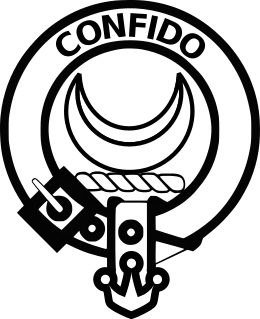Clan Durie facts for kids
Quick facts for kids Clan Durie |
|
|---|---|

Crest: A crescent Or
|
|
| Motto | CONFIDO (I trust) |
| Profile | |
| Region | Lowlands |
| District | Fife |
| Chief | |
 |
|
| Andrew Durie of Durie | |
| Chief of the Name and Arms of Durie | |
| Historic seat | Burntisland Castle |
The Durie family is a Scottish family from the Scottish Lowlands. It is important to know that they are a family, not a Scottish clan, even though some people might call them that.
Contents
History
Where Did the Durie Family Come From?
Many people used to think the Durie name came from the French words Du Roi, meaning "of the King." But this is not true! They also were not Normans who came to Scotland with Queen Margaret in 1069.
Modern history research shows that the Durie family started around 1260. A younger son of the Earl of Strathearn was given land in Fife that was already called Durie. He then took the name "of Durie" or "de Durie" to show where he was from.
The Duries owned land called Craigluscar near Dunfermline, Fife. They also had lands called Durie in the area of Scoonie, close to Leven, Fife. A house built around 1520 in Craigluscar has a stone with the initials of George Durie and his wife, Margaret Bruce.
The Durie family became well-known in Fife. Their name appears in many old documents from the 1200s and 1300s. For example, in 1258, Duncan de Dury was a witness for Malise, Earl of Strathern. The main family line comes from Richard de Douer, who lived around 1405.
In 1382, Burntisland Castle was built. It has a stone above the entrance showing the Durie family's coat of arms and the date 1554.
Important Times: 16th and 17th Centuries
Burntisland Castle was the largest property owned by the Durie family. In 1563, Mary, Queen of Scots even stayed there. However, the castle was later taken by the Crown during the Scottish Reformation, a time when Scotland changed its main religion.
George Durie was a very important person in both the church and the government. He was the last Abbot of Dunfermline before the Reformation. He also served in Parliament between 1540 and 1554. He was a member of the King's special council and the Keeper of the Privy Seal of Scotland.
George Durie strongly supported Mary, Queen of Scots. He was against the new religious changes. He even put his own cousin, John Durie, on trial for teaching the new faith. Queen Mary and her mother, the Queen-Dowager, wrote letters to George Durie when they were in trouble. They also sent him on important trips to France. George Durie later went to France himself, taking important religious items with him for safekeeping.
George Durie's brother was Andrew Durie, who was the Abbot of Melrose and Bishop of Galloway. Andrew Durie had disagreements with the religious reformer John Knox. He was put in Edinburgh Castle in 1580. Another Durie, Robert Durie, who was a minister, was sent away from Scotland for attending a church meeting that was not allowed.
George Durie's sons, John and George, both studied in Paris. Henry Durie, another of George's sons, owned the lands of Craigluscar. The main family line comes from him. His wife was Margaret MacBeth. She was known for her knowledge of herbs and medicines. Margaret helped at royal births at Dunfermline Palace and was a favorite of Anne of Denmark, the queen.
In the late 1600s, another George Durie was a Captain in King Louis XIV of France's Scots Guards. He was also a leader in Dunfermline.
Chief of the Name and Arms of Durie
For some time, the Durie family did not have a recognized chief. This changed in 1988 when Lt-Col Raymond Durie of Durie was recognized as the chief. He showed that he was a descendant of Abbot George Durie.
Raymond Durie had a long and impressive military career that lasted 35 years. He served with the Argyll and Sutherland Highlanders. He was recognized for his actions during the Chinese Civil War and Japan's invasion of China. He passed away in 1999. His son, Andrew Durie of Durie, is now the current chief.
Lands and Castles
The main home of the Durie family was Durie in the area of Scoonie, near Leven, Fife. Another part of the family, which includes the current Chief, lived at Craigluscar, near Dunfermline, Fife. For a short time, they also owned Rossend Castle (in Burntisland, Fife) and Grange (near Kinghorn, Fife).
See also


